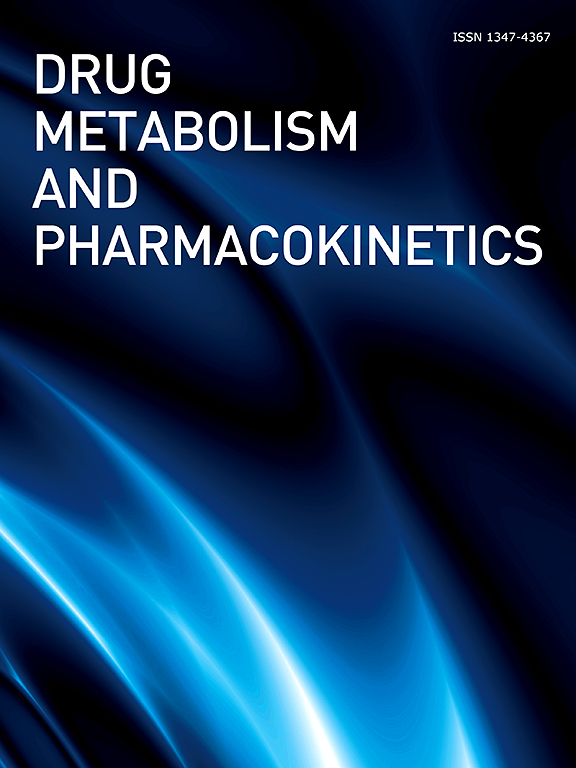Tyrosine kinase inhibitors, nilotinib and radotinib, suppress both catalytic function and mRNA expression of human cytochrome P450 2J2 and 2C8
IF 2.2
4区 医学
Q2 PHARMACOLOGY & PHARMACY
引用次数: 0
Abstract
Cytochrome P450 (P450 or CYP) 2J2, which metabolizes exogenous medicines and endogenous arachidonic acid to 14,15-epoxyeicosatrienoic acid (14,15-EET), is expressed in various organs and cancer cells. Additionally, CYP2C8 catalyzes the synthesis of 14,15-EET, a vasodilator that promotes cancer cell proliferation. However, the effect of tyrosine kinase inhibitors (TKIs) used in leukemia treatment on CYP2J2 and CYP2C8 remains unclear. This study investigated the effects of 16 TKIs used for leukemia treatment on recombinant CYP2J2-and CYP2C8-mediated processes. Among the TKIs, nilotinib and radotinib strongly inhibited CYP2J2-dependent astemizole O-demethylation and rivaroxaban hydroxylation, and CYP2C8-mediated paclitaxel 6α-hydroxylation (<20 %), with competitive inhibition constants of 0.41 and 0.22 μM, respectively (for astemizole O-demethylation). Nilotinib and radotinib suppressed CYP2J2-and CYP2C8-catalyzed arachidonic acid epoxidation and decreased their mRNA expression in Huh-7 cells (possibly via the peroxisome proliferator-activated receptor α pathway). Given that their inhibition constants are lower than their reported plasma concentrations, both may substantially suppress CYP2J2 and CYP2C8 functional enzyme levels and enzymatic activities in clinical settings. This suppression could potentially alter vasodilation by affecting 14,15-EET production, influencing CYP2J2 and CYP2C8-mediated drug-disease (conditions) and drug-drug interactions.
酪氨酸激酶抑制剂尼罗替尼和拉多替尼抑制人细胞色素P450 2J2和2C8的催化功能和mRNA表达
细胞色素P450 (P450或CYP) 2J2在各器官和癌细胞中表达,将外源性药物和内源性花生四烯酸代谢为14,15-环氧二碳三烯酸(14,15- eet)。此外,CYP2C8催化1415 - eet的合成,1415 - eet是一种促进癌细胞增殖的血管扩张剂。然而,用于白血病治疗的酪氨酸激酶抑制剂(TKIs)对CYP2J2和CYP2C8的影响尚不清楚。本研究探讨了16种用于白血病治疗的TKIs对重组cyp2j2和cyp2c8介导过程的影响。在TKIs中,尼罗替尼和拉多替尼对cyp2j2依赖性阿司咪唑o -去甲基化和利伐沙班羟化,以及cyp2c8介导的紫杉醇6α-羟化具有较强的抑制作用(< 20%),竞争抑制常数分别为0.41 μM和0.22 μM(对阿司咪唑o -去甲基化)。尼罗替尼和拉多替尼抑制了cyp2j2和cyp2c8催化的花生四烯酸环氧化,并降低了Huh-7细胞中它们的mRNA表达(可能通过过氧化物酶体增殖物激活受体α途径)。鉴于它们的抑制常数低于其报道的血浆浓度,两者都可能在临床环境中实质性地抑制CYP2J2和CYP2C8功能酶水平和酶活性。这种抑制可能通过影响14,15- eet的产生,影响CYP2J2和cyp2c8介导的药物-疾病(状况)和药物-药物相互作用来潜在地改变血管舒张。
本文章由计算机程序翻译,如有差异,请以英文原文为准。
求助全文
约1分钟内获得全文
求助全文
来源期刊
CiteScore
4.80
自引率
9.50%
发文量
50
审稿时长
69 days
期刊介绍:
DMPK publishes original and innovative scientific papers that address topics broadly related to xenobiotics. The term xenobiotic includes medicinal as well as environmental and agricultural chemicals and macromolecules. The journal is organized into sections as follows:
- Drug metabolism / Biotransformation
- Pharmacokinetics and pharmacodynamics
- Toxicokinetics and toxicodynamics
- Drug-drug interaction / Drug-food interaction
- Mechanism of drug absorption and disposition (including transporter)
- Drug delivery system
- Clinical pharmacy and pharmacology
- Analytical method
- Factors affecting drug metabolism and transport
- Expression of genes for drug-metabolizing enzymes and transporters
- Pharmacogenetics and pharmacogenomics
- Pharmacoepidemiology.

 求助内容:
求助内容: 应助结果提醒方式:
应助结果提醒方式:


